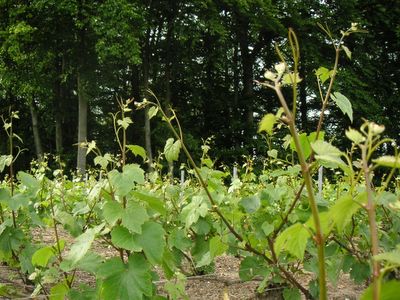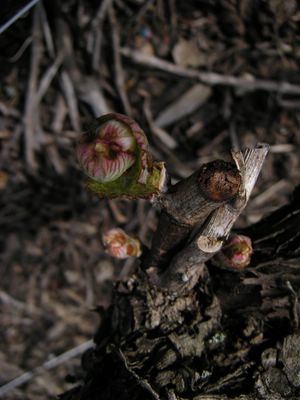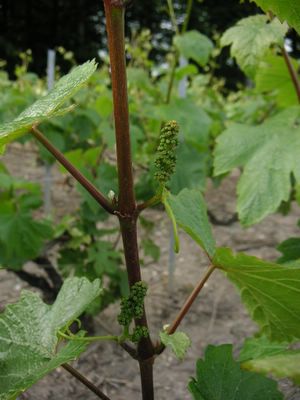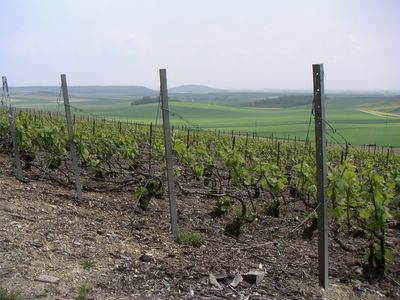På dansk
Lidt af hvert om stort og småt i Champagne/A bit of this & a bit of that with bubbly regards from Champagne
31 May, 2000
News May 2005
På dansk
27 May, 2000
Wild growth of the wine

Wine at Villers-Marmery in Montagne de Reims in late May.
Since the wine opened in late April, it has not done anything but grow. However at a slower speed than normal.
Even we now move towards midsummerday with pleasant smells of elder flower already declining and poppies in undulating red skirts at their zenith, the wine has not grown as much as usual. June has just been too cold.
Heat advances growth
Normally a vine grows optimally when the temperature of the air is between 25 and 30 degrees Celsius, and so far the mercury has only just passed 20 degrees and only in the middle of the afternoon. Which you see everywhere.
In our rows of wine the longest of the stems now have passed the top thread of the fence with up to half a meter. We see the same heigts everywhere we pass along the road between Louvois and Vertus with wellknown Côte de Blancs terroirs such as Cramant, Avize, le Mesnil and Oger. In most vineyards the wine so far has been left alone.
The first inertia of growth
The growth always begins slowly. As if the wine must overcome its own inertia before it sets moving.
One of the first signs of growth is the first two wrinkled leaves and they sure take their time, before they unfold from their conically shaped bud. Typically it takes around a week or so from the buds begin to be green until they swell and finally the leaves peep out through the two brown flakes, that has protected the bud during the winter.

The first leaves on their way in Trépail.
The different stages of the buds are carefully classified according to their development, for instance:
This detailed classification makes it easy to discuss the stage and development of the wine across stages, varieties and regions. Anyway the variations are not huge.

The Chardonnay grows in Givry-les-Loisy.
This year the average Chardonnay-grape came out on April 15th, while the Pinot Meunier followed four days later. The Pinot Noir unfolded right inbetween at April 17th, says the profesionnal publication Le Vigneron Champenois.
A vineyard is regarded as unfolded, when this is the case for more than half of its buds.
Burst of growth
When the first leaves are unfolded, the plant puts up the rate of growth. The stems fast develop more and more leaves on longer and longer stems, but also the leaves grow. Only after about a month they have reached their full size.
In this first part of the season a wine uses all its energy on the growth. The second part is dedicated to fertility. First stems, then follow grapes.

These future grapes have been out only a few days.
When four to six leaves have unfolded, the first fragile structures of grapes make their appearance on the stems. Since the little threads, that the wine uses to climb, join in. Only a few days old they become sensitive to touching and will begin to climb whenever they butt against something.
The growth is normally at its maximum in the month of June, where the days are at their longest. Every stem can in this period produce two new leaves per day, the young stems can grow several centimeters.
The powerstation of the wine
The early seaons burst of growth is all about energy. The wine is creating its powerstation of the summer. The leaves.
When they have developped into full size, they take over the production of nutrition. Since the wine woke up in early spring, it is the latex that has fed the plant.

Three-four weeks old wineleaves on a Chardonnay-plant.
Like any other green plant it is the photosynthesis, that produces the energy. It is the natural proces, in which leaves powered by sunlight convert carbon dioxide and water to sugar and oxygene. The sugar feeds the plant and matures the fruits. The oxygene makes it possible for humans and other mammals to breathe, but that is a completely different story.
Since the leaves assure the maturation of the grapes, it is of uttermost importance that there are enough leaves. Or rather, that the leaves are able to produce enough sugar.
As much sun as possible
The most important thing regarding the leaves is that they are well placed. A good placement means lots of sun, since leaves with sunlight can work optimally as power supplier. The amount and size are of lesser importance.
When the wine has grown a bit more - probably not long from now - we will trim the leaves first in the top and later on the sides too. This is why it is very important that the leaves that stay will get as much sunlight as possible.

The rows are orientated after the sun. Montaigne de Reims, May 9th.
For this reason you normally plant your wine so the rows will get the maximum amount of sun. In Champagne most of the rows are turned east-west wards. In warmer regions on the other hand you may choose to plant in order for the grapes to get as little sun as possible. Otherwise the grapes may mature too fast and most likely will not develop the more complex and interesting flavours.
The pleurs of March
On top of light a wine needs water. It is rather easily satisfied though. If it does not get the rain it needs, the roots will dig deeper to seek the water itself. The plant can also manage quite cold winters and warm summers. However, the grapes only mature in a certain spectrum of temperatures. There is a number of different varieties of wine where each of them have specialized in different weather-related, geological and other conditions.
The temperature decides when the wine wakes up in the spring and begins to grow. Typically when the temperature of the soil passes 13 degrees Celsius and the temperature of the air passes 10 degrees Celsius. This makes the roots absorb water, which eventually changes the condition of the latex from thick frostprotection to the thinner liquid of nutrition of the summer.

Chardonnay at Givry, view over Champagne Crayeuse.
It is the latex that flow, if you prune the wine after the growth has resumed. Pleurs de sang is the French name of the phenomenon, the wine cries, and it does quite right flow in surprisingly forceful amounts. As if you just committed a major assault towards the plant.
Even a major crybaby is normally not harmed by late pruning though.
All activity in the apex
As the juice reaches the buds they will begin to turn green, and from this point it is a matter of time before the wine opens.
Within each bud is the apex, that contains all types of structures: The stem itself, the leaves, the grapes and the climbing threads. From the apex the two first leaves unfold, then the stem grows a bit and more leaves emerges. Finally what will develop into the grapes and climbing threads will come out. Each specific feature with even and distinct spacing inbetween them.
The apex, where the growth takes place, sits on the outermost part of the stem. It sort of travels with the stem longer and longer away from the starting point. This means that the older part of the stem is closer to the old wood and the original bud, whereas the new growth takes place longer and longer from the starting point.
When we soon begin to chop of tops and sides of the wall of leaves, the apex - the centre of growth - will be cut off too. This however willl not stop the growth. On the contrary the wine will react to this assault by producing even more leaves in the same fashion as childrens hair. It grows even faster once it has been cut for the first time.
Other apex, that have developped from buds at each pair of leaves, will deliver the new growth. Therefor it will be necessary to cut the sides soon after the top has been cut of. This means that you will meet tractors in the streets on their way to the wine well into the month of July, where the growth normally slows down in order to start maturing the grapes. At this time the soft stems will harden into real wood.

Veuve Clicquot grows wine all over Champagne, this is Verzy early June.
På dansk
20 May, 2000
War against Champagnebrus
The guard dog of the Champagne winegrowers, CIVC (Comité Interprofessionnel du Vin de Champagne) is back on the warpath. It has come to their knowledte that a more than 100 years old Norwegian drink - without alcohol - is sold under the name champagnebrus. Even in big quantities and none of it ever saw a grape.
This is serious business. In Champagne people care about their name, which happens to be one of the tasks of the CIVC. Which is why the organisation has send a letter to the producers of the totally unacceptable norwegian soft drink to ask them to chanage the name at the latest by the 1st of May.
The brewery Ringnes has digged in its heels and announced that its soft drink, the Villa Champagnebrus, will have a new name in early May. This is not what you can see in their homepage so far but we trust their good intentions so far. After all, the forbidden name has only spend around 40 years on the label .
Much worse is it with the Egernsund Mineralvandfabrik AS with another product called Champagnebrus. The owner, Harald Berentsen, has stubbornly parked his heels in the norwegian cliff and refuse to rename his sparkling drink.
"I think this is amazing. We have produced champagnebrus since 1895 and never heard a thing from the french winegrowers", he says to norwegian TV2's homepage.
The norwegian lawyer of the CIV has put May 1st as the deadline, so now the fight will probably end in court. Just like in Germanu, where the federal court has just
ruled the name "Champagner bratbirne" illegal for the third time, writes the weppage Finance24.com.
It can only be a matter of time before the danish icecream will be sued.
På dansk
This is serious business. In Champagne people care about their name, which happens to be one of the tasks of the CIVC. Which is why the organisation has send a letter to the producers of the totally unacceptable norwegian soft drink to ask them to chanage the name at the latest by the 1st of May.
The brewery Ringnes has digged in its heels and announced that its soft drink, the Villa Champagnebrus, will have a new name in early May. This is not what you can see in their homepage so far but we trust their good intentions so far. After all, the forbidden name has only spend around 40 years on the label .
Much worse is it with the Egernsund Mineralvandfabrik AS with another product called Champagnebrus. The owner, Harald Berentsen, has stubbornly parked his heels in the norwegian cliff and refuse to rename his sparkling drink.
"I think this is amazing. We have produced champagnebrus since 1895 and never heard a thing from the french winegrowers", he says to norwegian TV2's homepage.
The norwegian lawyer of the CIV has put May 1st as the deadline, so now the fight will probably end in court. Just like in Germanu, where the federal court has just
ruled the name "Champagner bratbirne" illegal for the third time, writes the weppage Finance24.com.
It can only be a matter of time before the danish icecream will be sued.
På dansk
Subscribe to:
Comments (Atom)